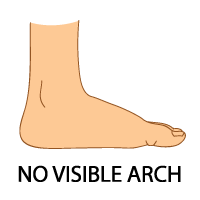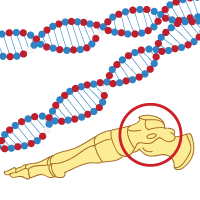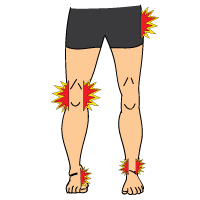What are “Flat Feet”?
Having flat feet (or fallen arches) means that you don’t have a visible arch in your foot. Babies and toddlers have flat feet because arches actually don’t develop until childhood. This is known as flexible flatfoot because while the arch may not be visible when the baby or toddler is standing, it is visible when they stand on their tip toes or are in a sitting position. If you don’t have a visible arch when you are standing, sitting, or up on your tip toes, this is called rigid flatfoot.
 Causes
Causes
Adults who have always had flexible flat feet have probably inherited the condition. However, rigid flat feet are often caused by another foot condition. These conditions include Tarsal Coalition, Congenital Vertical Talus and Lateral Subtalar Dislocation.
Some people can also lose their arch during adulthood because of conditions like arthritis or diabetic neuropathy.
Signs & Symptoms
In many cases, people with flexible flat feet won’t experience any symptoms. However, some people do experience foot pain and foot fatigue associated with the condition. These symptoms are often seen after long periods of physical activity.
Flat feet can often cause pain in other areas of the body, such as the hips, knees, ankles and legs. The lack of an arch in the foot causes these other areas of the body to bear the weight of your footfalls.
Treatments
If there are no symptoms associated with your flat feet, no treatment is necessary.
 Painkillers – NSAIDs such as ibuprofen and naproxen can be used to help relieve the pain associated with having flat feet.
Painkillers – NSAIDs such as ibuprofen and naproxen can be used to help relieve the pain associated with having flat feet.
Proper Footwear – Shoes that provide support, cushioning and shock absorption are important for people with flat feet. Try to avoid wearing high heels or sandals.
Physiotherapy – For people who are physically active, having flat feet can lead to repetitive strain injuries. A physiotherapist can help to prevent and/or treat this through stretching and strengthening exercises.
Treat the Underlying Condition – If your flat feet are the cause of an underlying condition (arthritis, Tarsal Coalition, Congenital Vertical Talus, etc.), treating the condition itself can bring relief of your symptoms.
Surgery – Surgery may be necessary to correct your flat feet if they are associated with a particular deformity or condition. In most cases though, surgery should only be considered as a last resort.